When Natalie Mackay toured her son’s elementary school, she asked how he might be included on the playground. The school suggested that her son, who used a wheelchair, could lay down a blanket on a graveled area to play. This kind of “solution,” in which children with disabilities are left to watch other children play in schools, tells all students that excluding some peers is OK, said Mackay. As a mom, she wanted to see her son and all children have exciting opportunities for play and socialization. So she founded Unlimited Play, a nonprofit dedicated to accessible and inclusive playground design. Inclusive playgrounds “were the vehicle that I thought would allow kids to get to know my son,” she said.
Playgrounds are a child’s “first outdoor classroom,” and where “they learn they belong to the community,” said Olenka Villarreal, CEO and founder of Magical Bridge Foundation, a nonprofit dedicated to universal, community and inclusive design. Playgrounds set the foundation for belonging and social inclusion for kids and adults of all abilities. But according to both Mackay and Villareal, accessibility standards for playgrounds laid out by the Americans with Disabilities Act (ADA) alone don’t encompass the specificities and expansiveness needed to create true inclusion on the playground. Mackay and Villarreal have made it their mission to redefine what it means for a playground to be truly accessible and inclusive of the full spectrum of ability and disability in the communities that the playgrounds serve. To them, playgrounds that are inclusive to all types of play can help to create a sense of belonging for everyone.
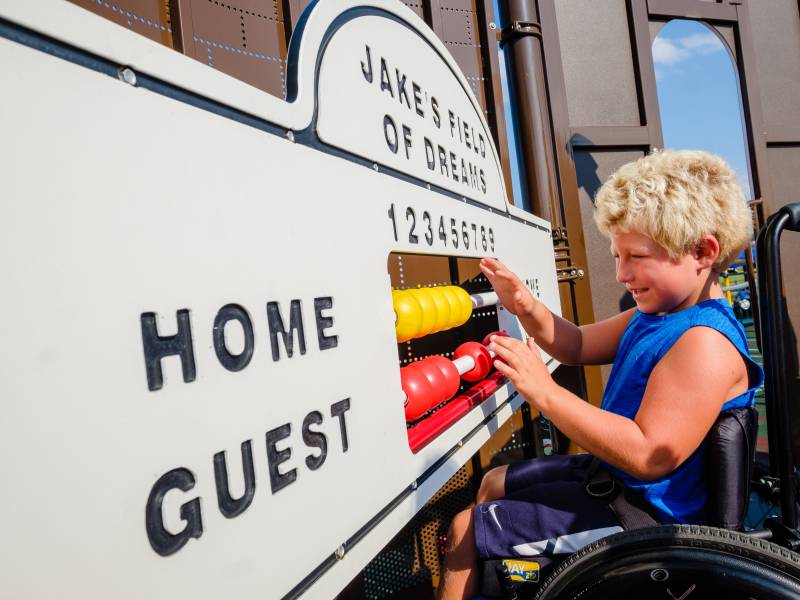
Unlimited Play’s Jake’s Field of Dreams Playground in Wentzville, Missouri opened in 2018. (Unlimited Play)
What does full accessibility look like?
For Villarreal, Magical Bridge Foundation was born organically to meet her own family’s needs. “I had one daughter with disabilities and one without, and I was looking for a place to take them both,” she said. Villarreal also acknowledged that abilities may change over time. “I want to be included in the body I live in today and the one I’m going to live in in 30 years,” she said. “When our spaces aren’t welcoming to us in whatever way we show up, it really creates divisions among everyone.”
According to Mackay, accessibility on playgrounds means removing barriers to play. She said that one of the first suggestions from parents that influenced her understanding of inclusion was to include fencing around play spaces for the safety of children who might elope. Inclusivity on the playground doesn’t begin and end with ramp access to the lower level of a structure or accessible pathways to a gated entrance. There are many more abilities to consider, like vision and hearing loss, sensory needs, and mobility and physical support needs. Social inclusion is also a big part of accessibility on a playground, said Mackay.
To make playgrounds accessible and inclusive for children and adults with visual impairments, Unlimited Play has used high contrasting colors in their designs. Mackay also emphasized the importance of situating public playgrounds in an area that has visual and auditory landmarks and direct access to public transportation. Villarreal said that it is important for “typically” developing children to play in these inclusive spaces because it exposes them to many different types of people and abilities.
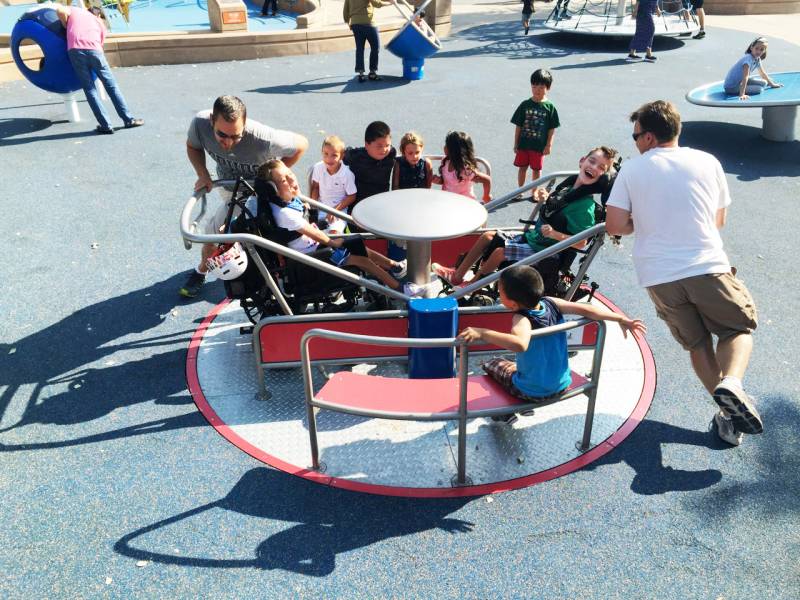
Magical Bridge Playground at Mitchell Park in Palo Alto, California opened in 2015. (Magical Bridge Foundation)
When it comes to safety on accessible playgrounds, Mackay suggested taking into consideration children who have difficulty with balance. For these children, inclusivity might take the form of tunnel slides instead of open ones, or choosing well thought out handholds throughout a structure.
Making sure that playgrounds are accessible and inclusive to parents and caregivers who have disabilities is also important. Children might miss out on opportunities to play if a playground or play space is not accessible to a parent with disabilities.
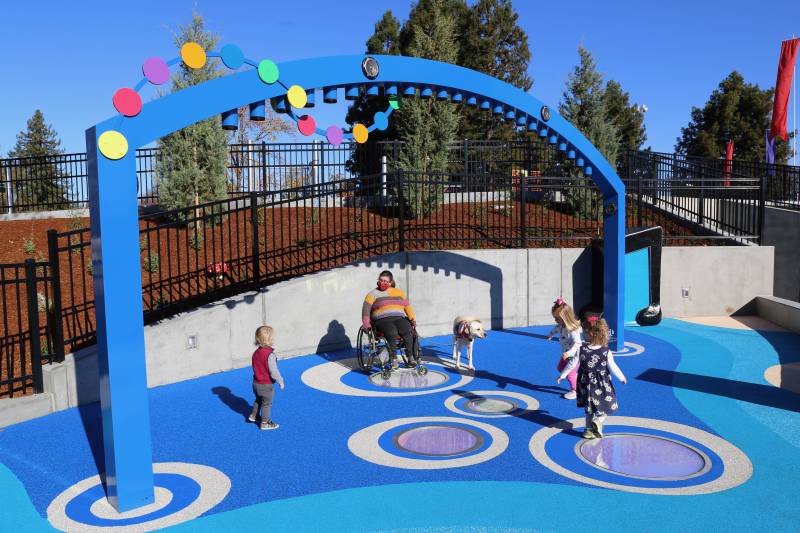
Magical Bridge Playground at Red Morton Park in Redwood City, California opened in 2021. (Magical Bridge Foundation)
At school playgrounds, most common structures like stairs, slides and swings aren’t designed with inclusion in mind, according to Villarreal. Regardless of ability, there need to be more movement options on playgrounds, she said. This could mean diversifying movement options to include more swinging and spinning elements, which can help children develop and stimulate their nervous systems. Villarreal also stressed the importance of removing the stigma around what may or may not be seen as age appropriate in a playground because developmental age is not always linked to physical age.
Funding barriers and low-cost solutions
Funding is one of the biggest hurdles for schools to create accessible playgrounds. For example, Mackay pointed to a recent school project that her organization designed that included three separate accessible and inclusive playgrounds for a total cost of about $900,000, paid for through a school bond. Each individual playground ranged in price from $150,000 to $450,000. Often, when schools have come up with funding to pay for more accessible playgrounds, it doesn’t cover the cost of a full design and installation, said Mackay. Often it means picking pieces that will contribute to more accessibility and inclusivity to an existing space, said Mackay. In Palo Alto, where The Magical Bridge Foundation is based, the Santa Clara County Board of Supervisors has offered grants to public agencies and nonprofits seeking to build inclusive playgrounds.
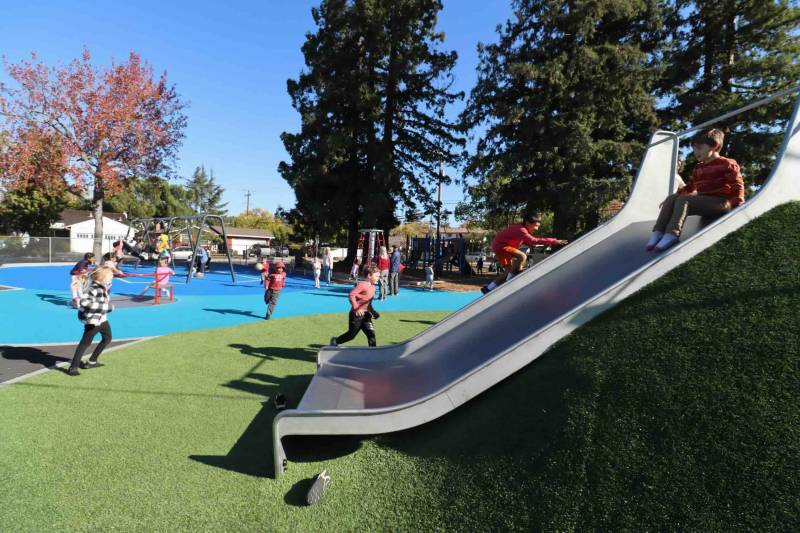
Magical Bridge Playground at El Carmelo Elementary School in Palo Alto, California opened in 2023. (Magical Bridge Foundation)
When looking for low-barrier and low-cost solutions to an otherwise inaccessible playground, Mackay recommended creating more shaded spaces, “even if it’s a tree with a bench.” And “if it’s a bench, put a space where somebody in a wheelchair can be there,” she said. According to Mackay, vertical panels with open ended activities like spinning pieces or a steering wheel cost around $1,200 each and can provide an interactive and socially inviting play space for all children. She suggested placing panel pieces in creative ways around the playground to provide more opportunities for different types of play and movement. Adding an adaptive swing with a high back and harness, designed for children with a variety of disabilities, also contributes to a more inclusive environment on the playground.
The playground at school is one of the places where students can learn about inclusive practices, even when a total playground overhaul isn’t in the current plans. If educators “teach [students] about inclusion in their classroom and then take them out to the playground and let them experience what that looks like,” then students might have a better understanding of how they might be able to be more inclusive in their own play, said Mackay. Unlimited Play offers partnerships with educators and schools to develop classroom curriculum to encourage inclusive play, including lesson plans on social awareness and effective communication. The Magical Bridge Foundation also offers learning materials for students, parents and educators online.
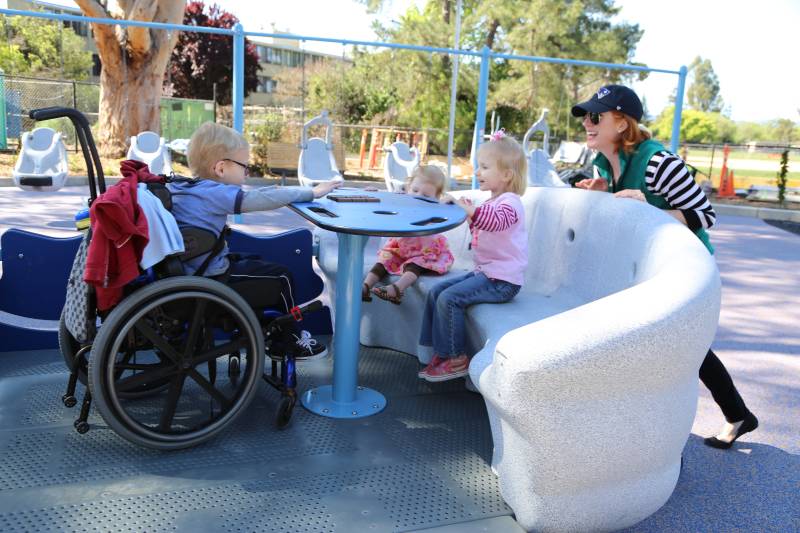
Magical Bridge Playground at Mitchell Park in Palo Alto, California opened in 2015. (Magical Bridge Foundation)
Connecting with community partners about providing services can help a project along, said Mackay, who is most often contacted by families looking for inclusive solutions to playgrounds in their areas. She works with those families to establish community connections who might want to be involved in the process of creating an inclusive playground. Some of Mackay’s most successful partnerships have been with other nonprofits that serve children with disabilities. The Magical Bridge Foundation also trains volunteers or Kindness Ambassadors, who then offer read-aloud sessions, musical performances and art education at their playgrounds. These volunteers and employees also have varying abilities and disabilities, so that children can experience the diversity that already exists in their community.

Magical Bridge Playground at Claudelands Park in Hamilton, New Zealand opened in 2023. (Magical Bridge Foundation)
Continue reading...
Playgrounds are a child’s “first outdoor classroom,” and where “they learn they belong to the community,” said Olenka Villarreal, CEO and founder of Magical Bridge Foundation, a nonprofit dedicated to universal, community and inclusive design. Playgrounds set the foundation for belonging and social inclusion for kids and adults of all abilities. But according to both Mackay and Villareal, accessibility standards for playgrounds laid out by the Americans with Disabilities Act (ADA) alone don’t encompass the specificities and expansiveness needed to create true inclusion on the playground. Mackay and Villarreal have made it their mission to redefine what it means for a playground to be truly accessible and inclusive of the full spectrum of ability and disability in the communities that the playgrounds serve. To them, playgrounds that are inclusive to all types of play can help to create a sense of belonging for everyone.

Unlimited Play’s Jake’s Field of Dreams Playground in Wentzville, Missouri opened in 2018. (Unlimited Play)
What does full accessibility look like?
For Villarreal, Magical Bridge Foundation was born organically to meet her own family’s needs. “I had one daughter with disabilities and one without, and I was looking for a place to take them both,” she said. Villarreal also acknowledged that abilities may change over time. “I want to be included in the body I live in today and the one I’m going to live in in 30 years,” she said. “When our spaces aren’t welcoming to us in whatever way we show up, it really creates divisions among everyone.”
According to Mackay, accessibility on playgrounds means removing barriers to play. She said that one of the first suggestions from parents that influenced her understanding of inclusion was to include fencing around play spaces for the safety of children who might elope. Inclusivity on the playground doesn’t begin and end with ramp access to the lower level of a structure or accessible pathways to a gated entrance. There are many more abilities to consider, like vision and hearing loss, sensory needs, and mobility and physical support needs. Social inclusion is also a big part of accessibility on a playground, said Mackay.
To make playgrounds accessible and inclusive for children and adults with visual impairments, Unlimited Play has used high contrasting colors in their designs. Mackay also emphasized the importance of situating public playgrounds in an area that has visual and auditory landmarks and direct access to public transportation. Villarreal said that it is important for “typically” developing children to play in these inclusive spaces because it exposes them to many different types of people and abilities.

Magical Bridge Playground at Mitchell Park in Palo Alto, California opened in 2015. (Magical Bridge Foundation)
When it comes to safety on accessible playgrounds, Mackay suggested taking into consideration children who have difficulty with balance. For these children, inclusivity might take the form of tunnel slides instead of open ones, or choosing well thought out handholds throughout a structure.
Making sure that playgrounds are accessible and inclusive to parents and caregivers who have disabilities is also important. Children might miss out on opportunities to play if a playground or play space is not accessible to a parent with disabilities.

Magical Bridge Playground at Red Morton Park in Redwood City, California opened in 2021. (Magical Bridge Foundation)
At school playgrounds, most common structures like stairs, slides and swings aren’t designed with inclusion in mind, according to Villarreal. Regardless of ability, there need to be more movement options on playgrounds, she said. This could mean diversifying movement options to include more swinging and spinning elements, which can help children develop and stimulate their nervous systems. Villarreal also stressed the importance of removing the stigma around what may or may not be seen as age appropriate in a playground because developmental age is not always linked to physical age.
Funding barriers and low-cost solutions
Funding is one of the biggest hurdles for schools to create accessible playgrounds. For example, Mackay pointed to a recent school project that her organization designed that included three separate accessible and inclusive playgrounds for a total cost of about $900,000, paid for through a school bond. Each individual playground ranged in price from $150,000 to $450,000. Often, when schools have come up with funding to pay for more accessible playgrounds, it doesn’t cover the cost of a full design and installation, said Mackay. Often it means picking pieces that will contribute to more accessibility and inclusivity to an existing space, said Mackay. In Palo Alto, where The Magical Bridge Foundation is based, the Santa Clara County Board of Supervisors has offered grants to public agencies and nonprofits seeking to build inclusive playgrounds.

Magical Bridge Playground at El Carmelo Elementary School in Palo Alto, California opened in 2023. (Magical Bridge Foundation)
When looking for low-barrier and low-cost solutions to an otherwise inaccessible playground, Mackay recommended creating more shaded spaces, “even if it’s a tree with a bench.” And “if it’s a bench, put a space where somebody in a wheelchair can be there,” she said. According to Mackay, vertical panels with open ended activities like spinning pieces or a steering wheel cost around $1,200 each and can provide an interactive and socially inviting play space for all children. She suggested placing panel pieces in creative ways around the playground to provide more opportunities for different types of play and movement. Adding an adaptive swing with a high back and harness, designed for children with a variety of disabilities, also contributes to a more inclusive environment on the playground.
The playground at school is one of the places where students can learn about inclusive practices, even when a total playground overhaul isn’t in the current plans. If educators “teach [students] about inclusion in their classroom and then take them out to the playground and let them experience what that looks like,” then students might have a better understanding of how they might be able to be more inclusive in their own play, said Mackay. Unlimited Play offers partnerships with educators and schools to develop classroom curriculum to encourage inclusive play, including lesson plans on social awareness and effective communication. The Magical Bridge Foundation also offers learning materials for students, parents and educators online.

Magical Bridge Playground at Mitchell Park in Palo Alto, California opened in 2015. (Magical Bridge Foundation)
Connecting with community partners about providing services can help a project along, said Mackay, who is most often contacted by families looking for inclusive solutions to playgrounds in their areas. She works with those families to establish community connections who might want to be involved in the process of creating an inclusive playground. Some of Mackay’s most successful partnerships have been with other nonprofits that serve children with disabilities. The Magical Bridge Foundation also trains volunteers or Kindness Ambassadors, who then offer read-aloud sessions, musical performances and art education at their playgrounds. These volunteers and employees also have varying abilities and disabilities, so that children can experience the diversity that already exists in their community.

Magical Bridge Playground at Claudelands Park in Hamilton, New Zealand opened in 2023. (Magical Bridge Foundation)
Continue reading...

